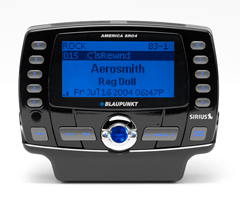Currently, most
enjoy satellite radio in their cars. With more then 100 channels of
music, news, sports, and entertainment, you'll be sure to find something
you want. It's a great way to enjoy a long drive too, knowing you'll
never lose a channel to static interference or poor reception.
But satellite radio
is for more than just a single car. Many people don't realize some satellite
radio components can be swapped between cars or even from car to home.
Connecting satellite radio to your home sound system gives you an array
of great options you won't get with traditional over the air radio signals.
For satellite radio,
here's what you need to get started:
- A satellite
radio antenna.
- A control module
-- either a separate control module with display panel that allows
you to select channels, or a receiver with built-in satellite radio
controls .
- A tuner module,
which delivers the satellite signal received by the antenna to the
control module. (These can be in a single piece of equipment.)
- A subscription
(around $12 a month) to either XM or Sirius.
Ways to add satellite
radio to your car:
1. Buy a
new system for your car - A popular way to get satellite radio
is to replace your car radio with an in-dash receiver that has built-in
satellite radio controls, and add a same-brand, satellite radio tuner
that mounts out of sight. Many major car audio manufacturers make either
Sirius or XM tuned equipment. Tuners and controllers from different
manufacturers won't work together.
2. Add satellite
radio to your existing car stereo - If you want to keep your
current radio, you can purchase an FM modulated package. FM modulators
send a signal to an unused frequency on your radio through the FM antenna
jack.
3. Bring
satellite radio from car to home - Sony makes a plug-and-play
XM tuner, that lets you enjoy satellite radio in your car and living
room. In the car, you can use the RF modulator to connect it to your
receiver, use a cassette adapter that fits into the cassette deck opening,
or connect it directly to your receiver's auxiliary input. You'll need
an antenna connection, as well. At home, you'll simply connect it to
your receiver with a docking kit, mount an optional antenna, and get
all of your favorite channels any time of day.
Sony's tuner is
also a good choice if you have more than one vehicle -- you can carry
the tuner from one car to the next, and only pay one subscription fee.
What about
an antenna? Unlike the tuners and controllers, you're not limited
to purchasing from the same manufacturer when you buy an antenna. Car
antennas mount on the roof (the wires wrap around the rear glass molding);
some mount on the rear glass.
Which service provider
should I use? This depends on your choice of equipment manufacturer.
Satellite radio gear is specific to either XM or Sirius; for instance,
Kenwood receivers are Sirius-ready. Both offer a variety of music, entertainment,
and sports programming, but the services have different channel lineups.
Sirius Radio has partnered with Ford-Lincoln-Mercury automobiles and
is available as an installed option in some models.
XM Radio has partnered
with General Motors -Cadillac -Buick automobiles and is available as
an installed option in some models.
See Part 1 - Satellite
Radio FAQ




